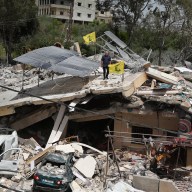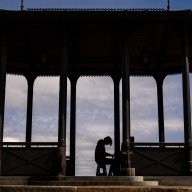RIKUZENTAKATA, Japan – Yukiko Yamaguchi wants to go home.
But like more than 400,000 others staying in shelters since a powerful tsunami plowed through their homes 10 days ago, the 73-year-old has no idea when she’ll be able to. Rebuilding Japan’s northeast coast is expected to take years, and the monumental effort is not even close to beginning.
Instead, another phase is slowly getting off the ground: the construction of prefabricated homes as temporary housing for the displaced.
“We’re anxious to leave here,” Yamaguchi said, sitting with her husband on a woven mat in a middle-school gym that has been their home since the town of Rikuzentakata was flattened by the raging torrent of water on March 11.
On Monday, construction workers outside the school screwed in the corrugated aluminum rooftop of one of the first temporary homes to spring up: a metal-sided box raised on wooden stilts above a muddy soccer field.
The house is one of 135 that will be built at the school by the Iwate provincial government, and one of thousands that will go up in the coming months outside other shelters scattered across Rikuzentakata’s hilly outskirts. Residents will likely stay in them for a couple of years until more permanent homes are ready.
“It’s simple and easy to feed people,” Yamaguchi said, referring to the meals prepared daily at her shelter, where laundry hangs in classrooms. “But the question everybody is asking is, when can we go home? We want to know how they plan to rebuild this town.”
So far, there are no answers.
The epic task of removing the debris must be completed first, and firefighters and soldiers are still removing bodies from the rubble. In Rikuzentakata, bulldozers began demolishing a few uninhabitable homes Monday. The steel claw of one earth-moving machine ripped off a green rooftop and dropped it in a mountain of twisted beams.
Elsewhere in the rubble, one woman stood, mouth agape, over a rectangular sheet of white metal that had been crushed to half its original size. “This is the front door of our house,” she said in disbelief. Only a square concrete foundation remained.
The rest was carried away by the tsunami as it pushed more than three miles (five kilometres) up a river. When the wave receded, it left a mud-covered plain of wrecked cars and nail-studded wooden planks, mixed in with what once made up lives here: smashed pianos, soiled picture albums, torn shoes.
As authorities collate the casualties, the toll steadily rises. Japanese authorities say more than 8,600 people are confirmed dead and 13,200 are missing.
“It’s all so hard to believe,” said Tsutomu Nakai, 61, a former secretary general of Rikuzentakata’s chamber of commerce who runs the shelter where Yamaguchi is staying — a hilltop junior high-school housing nearly 1,000 people.
Nakai, too, wonders when he’ll be able to go home. The hardest thing, he said, is the sudden dependence on charity. He has no identification, no credit cards, no money. He wonders what difference it would make anyway — even the banks were swept away. The charcoal-grey sweater he is wearing was given to him by a friend.
“I have trouble sleeping,” he said. “I want to believe this isn’t real, but it is.”
He said he would rebuild, though he was unsure how. “I was born here. I will spend the rest of my life trying to rebuild this place,” he said.
Some say it’s too dangerous to live next to the water.
“I can never see myself living here again,” 75-year-old Minoru Sato said in Onagawa, a harbour town to the south, as he picked through remnants of his shattered apartment. He found a photo of himself on a ski trip and stuffed it into a plastic bag.
Kadzuhiko Kimuri, another Onagawa resident, said some towns would never be the same. “I don’t see how they can ever rebuild it. I think most people will never come back — especially not the young generation,” he said. “There weren’t many jobs here for them, and now there are none.”
















